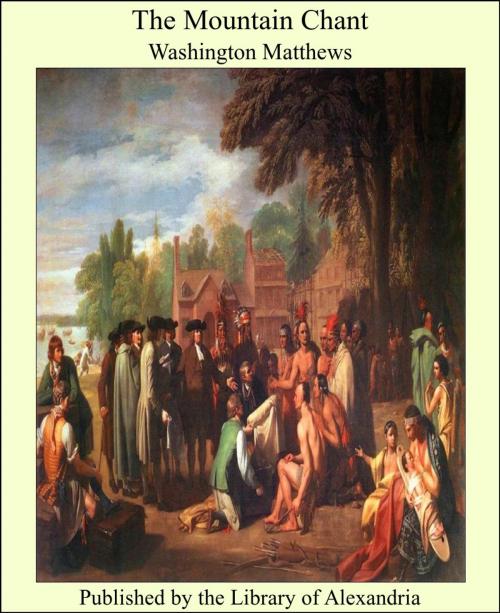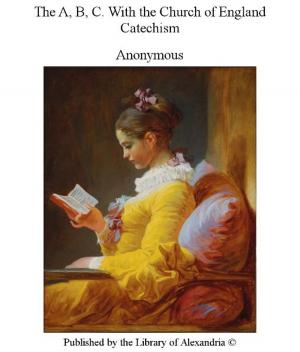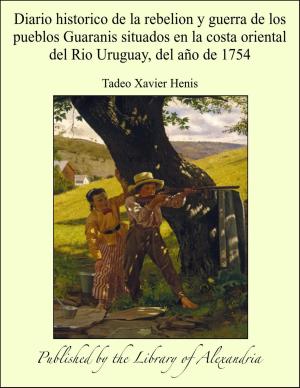| Author: | Washington Matthews | ISBN: | 9781613104507 |
| Publisher: | Library of Alexandria | Publication: | March 8, 2015 |
| Imprint: | Language: | English |
| Author: | Washington Matthews |
| ISBN: | 9781613104507 |
| Publisher: | Library of Alexandria |
| Publication: | March 8, 2015 |
| Imprint: | |
| Language: | English |
The ceremony of dsilyídje qaçàl, or mountain chant—literally, chant towards (a place) within the mountains—is one of a large number practiced by the shamans, or medicine men, of the Navajo tribe. I have selected it as the first of those to be described, because I have witnessed it the most frequently, because it is the most interesting to the Caucasian spectator, and because it is the best known to the whites who visit and reside in and around the Navajo country. Its chief interest to the stranger lies in the various public performances of the last night. Like other great rites of the shamans, it has its secret ceremonies of many days’ duration in the medicine lodge; but, unlike the others, it ends with a varied show in the open air, which all are invited to witness. another ceremony which I have attended, and which the whites usually call the “Ya?bichy Dance” (Yèbitcai), has a final public exhibition which occupies the whole night, but it is unvaried. Few Europeans can be found who have remained awake later than midnight to watch it. Such is not the case with the rite now to be described. Here the white man is rarely the first to leave at dawn. 2. The appropriateness of the name dsilyídje or tsilgitce—towards (a place) within the mountains—will be better understood from the myth than from any brief description. “Dsilyi‘” may well allude to mountains in general or to the Carrizo Mountains in particular, to the place in the mountains (paragraphs 9 and 38) where the originator of these ceremonies (whom I often find it convenient to call “prophet”) dwelt, or to the name of the prophet (par. 41), or to all these combined. Qaçàl signifies a sacred song or a collection of sacred songs. From the many English synonyms for song I have selected the word chant to translate qaçàl. In its usual signification hymnody may be its more exact equivalent, but it is a less convenient term than chant. The shaman, or medicine man, who is master of ceremonies, is known as qaçàli or chanter—el cantador, the Mexicans call him. In order to keep in mind his relationship to similar functionaries in other tribes I shall, from time to time, allude to him as the priest, the shaman, or the medicine man, following the example of other authors. To all ceremonies of a character similar to this the term qaçàl is applicable. It would seem from this that the Navajo regard the song as the chief part of the ceremony, but since the Americans, as a rule, regard all Indian ceremonies as merely dances and call them dances, I will, out of deference to a national prejudice, frequently refer to the ceremony as a dance. 3. Sometimes the collective rites and amusements of the last night are spoken of as ilnasjíngo qaçàl, or chant in the dark circle of branches, from il, branches of a tree; nas, surrounding, encircling; jin, dark; and go, in. The name alludes to the great fence of piñon branches, erected after sunset on the last night, to receive the guests and performers. I shall often refer to this inclosure as the corral. Some white men call the rites I describe the “corral dance,” but more usually they call them the “hoshkàwn dance,” from one of the minor performances of the last night, the hackàn-inçá‘, or act of the Yucca baccata, a rite or drama which seems to particularly excite the Caucasian interest. To such minor acts the terms inçá‘ and alìli are applied; these may be translated dance, show, act, or exhibition. 4. The purposes of the ceremony are various. Its ostensible reason for existence is to cure disease; but it is made the occasion for invoking the unseen powers in behalf of the people at large for various purposes, particularly for good crops and abundant rains. It would appear that it is also designed to perpetuate their religious symbolism. Some of the shows of the last night are undoubtedly intended to be dramatic and entertaining as well as religious, while the merely social element of the whole affair is obvious. It is an occasion when the people gather to have a jolly time. The patient pays the expenses and, probably in addition to the favor and help of the gods and the praise of the priesthood, hopes to obtain social distinction for his liberality
The ceremony of dsilyídje qaçàl, or mountain chant—literally, chant towards (a place) within the mountains—is one of a large number practiced by the shamans, or medicine men, of the Navajo tribe. I have selected it as the first of those to be described, because I have witnessed it the most frequently, because it is the most interesting to the Caucasian spectator, and because it is the best known to the whites who visit and reside in and around the Navajo country. Its chief interest to the stranger lies in the various public performances of the last night. Like other great rites of the shamans, it has its secret ceremonies of many days’ duration in the medicine lodge; but, unlike the others, it ends with a varied show in the open air, which all are invited to witness. another ceremony which I have attended, and which the whites usually call the “Ya?bichy Dance” (Yèbitcai), has a final public exhibition which occupies the whole night, but it is unvaried. Few Europeans can be found who have remained awake later than midnight to watch it. Such is not the case with the rite now to be described. Here the white man is rarely the first to leave at dawn. 2. The appropriateness of the name dsilyídje or tsilgitce—towards (a place) within the mountains—will be better understood from the myth than from any brief description. “Dsilyi‘” may well allude to mountains in general or to the Carrizo Mountains in particular, to the place in the mountains (paragraphs 9 and 38) where the originator of these ceremonies (whom I often find it convenient to call “prophet”) dwelt, or to the name of the prophet (par. 41), or to all these combined. Qaçàl signifies a sacred song or a collection of sacred songs. From the many English synonyms for song I have selected the word chant to translate qaçàl. In its usual signification hymnody may be its more exact equivalent, but it is a less convenient term than chant. The shaman, or medicine man, who is master of ceremonies, is known as qaçàli or chanter—el cantador, the Mexicans call him. In order to keep in mind his relationship to similar functionaries in other tribes I shall, from time to time, allude to him as the priest, the shaman, or the medicine man, following the example of other authors. To all ceremonies of a character similar to this the term qaçàl is applicable. It would seem from this that the Navajo regard the song as the chief part of the ceremony, but since the Americans, as a rule, regard all Indian ceremonies as merely dances and call them dances, I will, out of deference to a national prejudice, frequently refer to the ceremony as a dance. 3. Sometimes the collective rites and amusements of the last night are spoken of as ilnasjíngo qaçàl, or chant in the dark circle of branches, from il, branches of a tree; nas, surrounding, encircling; jin, dark; and go, in. The name alludes to the great fence of piñon branches, erected after sunset on the last night, to receive the guests and performers. I shall often refer to this inclosure as the corral. Some white men call the rites I describe the “corral dance,” but more usually they call them the “hoshkàwn dance,” from one of the minor performances of the last night, the hackàn-inçá‘, or act of the Yucca baccata, a rite or drama which seems to particularly excite the Caucasian interest. To such minor acts the terms inçá‘ and alìli are applied; these may be translated dance, show, act, or exhibition. 4. The purposes of the ceremony are various. Its ostensible reason for existence is to cure disease; but it is made the occasion for invoking the unseen powers in behalf of the people at large for various purposes, particularly for good crops and abundant rains. It would appear that it is also designed to perpetuate their religious symbolism. Some of the shows of the last night are undoubtedly intended to be dramatic and entertaining as well as religious, while the merely social element of the whole affair is obvious. It is an occasion when the people gather to have a jolly time. The patient pays the expenses and, probably in addition to the favor and help of the gods and the praise of the priesthood, hopes to obtain social distinction for his liberality















